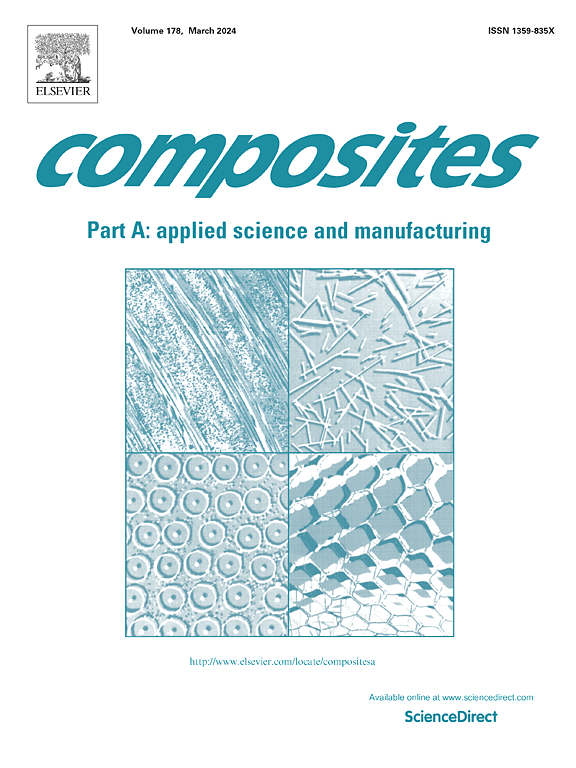Effect of core–shell structure formed by Y2O3-doping on cracking inhibition in SLMed Y2O3/Mar-M247 alloy
IF 8.1
2区 材料科学
Q1 ENGINEERING, MANUFACTURING
Composites Part A: Applied Science and Manufacturing
Pub Date : 2025-04-23
DOI:10.1016/j.compositesa.2025.108981
引用次数: 0
Abstract
To reduce cracking in Mar-M247 superalloy of Selective Laser Melting (SLM) manufacturing, this research explores the impact of the core–shell structure formed by adding different contents (0.5 and 1.0 wt%) of Y2O3 nanoparticles on the microstructure, crack behavior, and mechanical properties. Y2O3-doping facilitates the transition from columnar to equiaxed grains in the SLM process. The reaction of Y2O3 nanoparticles with oxide-forming elements in Mar-M247 alloy promotes the formation of Y2Hf2O7, which could act as the nucleation sites for MC carbides, forming a core–shell structure with Y2Hf2O7 as the core and MC carbides as the shell. The dispersed core–shell nanoparticles lead to the distribution of carbides both inside cells and at the cell boundaries, contribute to the reduction of dislocations pinned by MC carbides near the core–shell structure, and reduce the formation of dislocation walls, which helps to inhibit cracking. Moreover, both the γ′ phase and the core–shell structures can impede dislocation motion, alleviating local stress concentration at cell boundaries. The effect of Y2O3 nanoparticles on the metallurgical behavior of the molten pool and precipitation characteristics during the SLM process is analyzed to reveal the mechanism of the interactions between precipitates and dislocations as well as the crack inhibition.
Y2O3掺杂形成核壳结构对SLMed Y2O3/Mar-M247合金缓裂性能的影响
为了减少选择性激光熔化(SLM)制造Mar-M247高温合金的裂纹,本研究探讨了添加不同含量(0.5 wt%和1.0 wt%)的Y2O3纳米颗粒形成的核壳结构对显微组织、裂纹行为和力学性能的影响。y2o3的掺杂促进了SLM过程中柱状晶粒向等轴晶粒的转变。在Mar-M247合金中,Y2O3纳米颗粒与形成氧化物的元素反应促进了Y2Hf2O7的生成,Y2Hf2O7可以作为MC碳化物的成核位,形成以Y2Hf2O7为核、MC碳化物为壳的核壳结构。分散的核壳纳米颗粒使碳化物在细胞内和细胞边界均有分布,有助于减少核壳结构附近MC碳化物所钉住的位错,减少位错壁的形成,有助于抑制裂纹。此外,γ′相和核壳结构都可以阻碍位错运动,减轻细胞边界的局部应力集中。分析了Y2O3纳米颗粒对熔池冶金行为和SLM过程中析出特征的影响,揭示了析出相与位错相互作用以及裂纹抑制的机理。
本文章由计算机程序翻译,如有差异,请以英文原文为准。
求助全文
约1分钟内获得全文
求助全文
来源期刊

Composites Part A: Applied Science and Manufacturing
工程技术-材料科学:复合
CiteScore
15.20
自引率
5.70%
发文量
492
审稿时长
30 days
期刊介绍:
Composites Part A: Applied Science and Manufacturing is a comprehensive journal that publishes original research papers, review articles, case studies, short communications, and letters covering various aspects of composite materials science and technology. This includes fibrous and particulate reinforcements in polymeric, metallic, and ceramic matrices, as well as 'natural' composites like wood and biological materials. The journal addresses topics such as properties, design, and manufacture of reinforcing fibers and particles, novel architectures and concepts, multifunctional composites, advancements in fabrication and processing, manufacturing science, process modeling, experimental mechanics, microstructural characterization, interfaces, prediction and measurement of mechanical, physical, and chemical behavior, and performance in service. Additionally, articles on economic and commercial aspects, design, and case studies are welcomed. All submissions undergo rigorous peer review to ensure they contribute significantly and innovatively, maintaining high standards for content and presentation. The editorial team aims to expedite the review process for prompt publication.
 求助内容:
求助内容: 应助结果提醒方式:
应助结果提醒方式:


